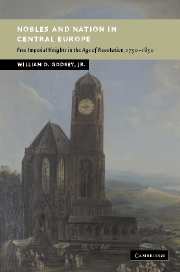Book contents
- Frontmatter
- Contents
- Preface
- Abbreviations
- Introduction
- 1 Wealth and noble autonomy: the Free Imperial Knights in Mainz on the eve of revolution
- 2 Nobles becoming Germans: the transformation of a concept
- 3 Nobles becoming Germans: the destruction of a “geo-cultural landscape”
- 4 Between destruction and survival: knights on the Middle Rhine 1750–1850
- 5 The past recaptured: knights in the Hapsburg Empire 1792–1848
- 6 From cathedral canons to priests: the Coudenhoves and the “Catholic revival”
- 7 The beginnings of conservative German nationalism: the “naturalization” of Baron Carl vom und zum Stein (1757–1831)
- Conclusion
- Appendix: Families of Free Imperial Knights (1797)
- Bibliography
- Index
Conclusion
Published online by Cambridge University Press: 01 October 2009
- Frontmatter
- Contents
- Preface
- Abbreviations
- Introduction
- 1 Wealth and noble autonomy: the Free Imperial Knights in Mainz on the eve of revolution
- 2 Nobles becoming Germans: the transformation of a concept
- 3 Nobles becoming Germans: the destruction of a “geo-cultural landscape”
- 4 Between destruction and survival: knights on the Middle Rhine 1750–1850
- 5 The past recaptured: knights in the Hapsburg Empire 1792–1848
- 6 From cathedral canons to priests: the Coudenhoves and the “Catholic revival”
- 7 The beginnings of conservative German nationalism: the “naturalization” of Baron Carl vom und zum Stein (1757–1831)
- Conclusion
- Appendix: Families of Free Imperial Knights (1797)
- Bibliography
- Index
Summary
Individual Estates — generally nobles, clergy, and burghers — together constituted the early modern “nation” in Western and Central Continental Europe, with the bodies politic in areas otherwise as diverse as Lower Austria and Burgundy bearing remarkable similarities. The imperial Diet at Regensburg seated nobles, prelates, and delegates of the immediate imperial towns. As a result of their centuries-long struggle against the territorial princes, their correspondingly complex constitutional history, and their relatively late arrival (ca. 1550) as an immediate imperial corporation, the Free Imperial Knights had no direct representation in the Diet. The pedigreed Catholics among their number, in combination with the Church that they dominated, nevertheless made up one of the most exclusive corporations in the Empire. Through their control alone of Mainz, they claimed the Empire's ranking electoral dignity and thereby an unusually privileged place in the traditional “nation.” If that were not enough, Mainz's ruler directed as imperial arch-chancellor (Reichserzkanzler) the very political expression of that nation: the diet at Regensburg. The early modern German commonwealth furthermore found perhaps its most convincing expression in places such as the ecclesiastical states where the relationship between the ruler, in this case the emperor, and the representatives of the “nation,” here nobles and clergy, was at its most symbiotic. Dominion in the Holy Roman Empire differed only in degree rather than in theory from that in both the hereditary lands of the House of Austria and the French ancien régime.
- Type
- Chapter
- Information
- Nobles and Nation in Central EuropeFree Imperial Knights in the Age of Revolution, 1750–1850, pp. 249 - 254Publisher: Cambridge University PressPrint publication year: 2004

